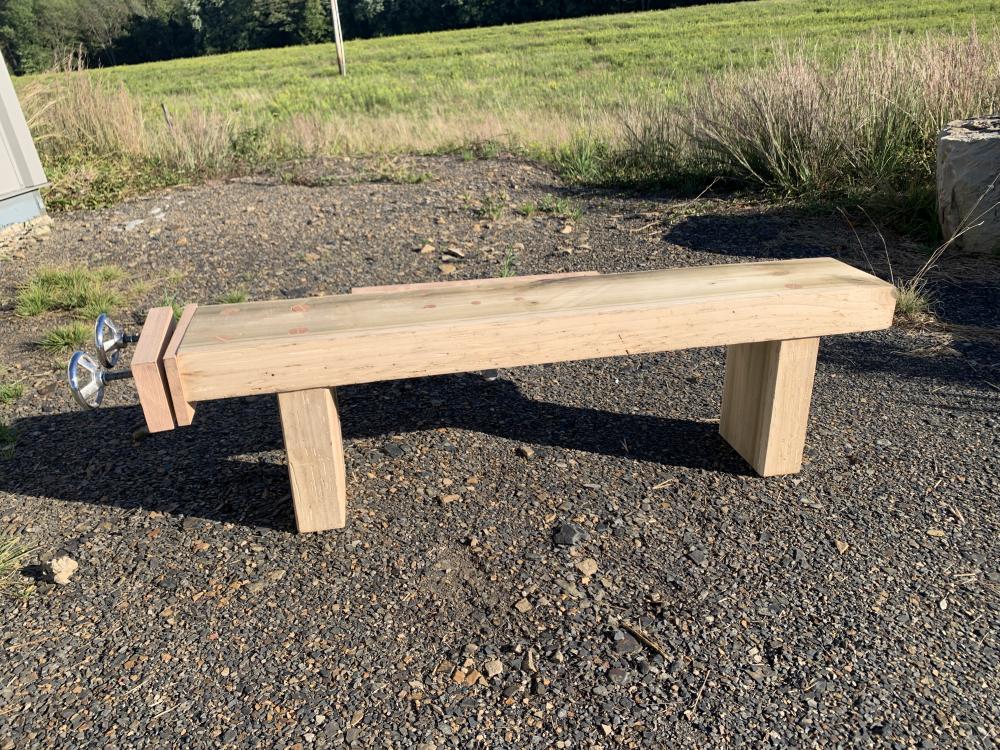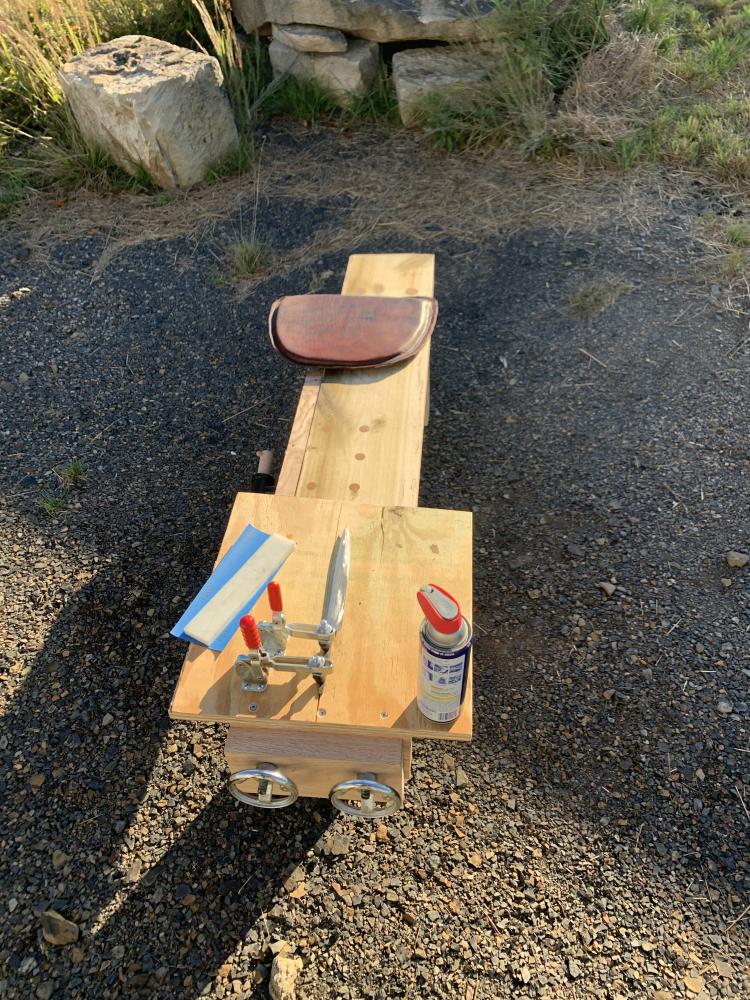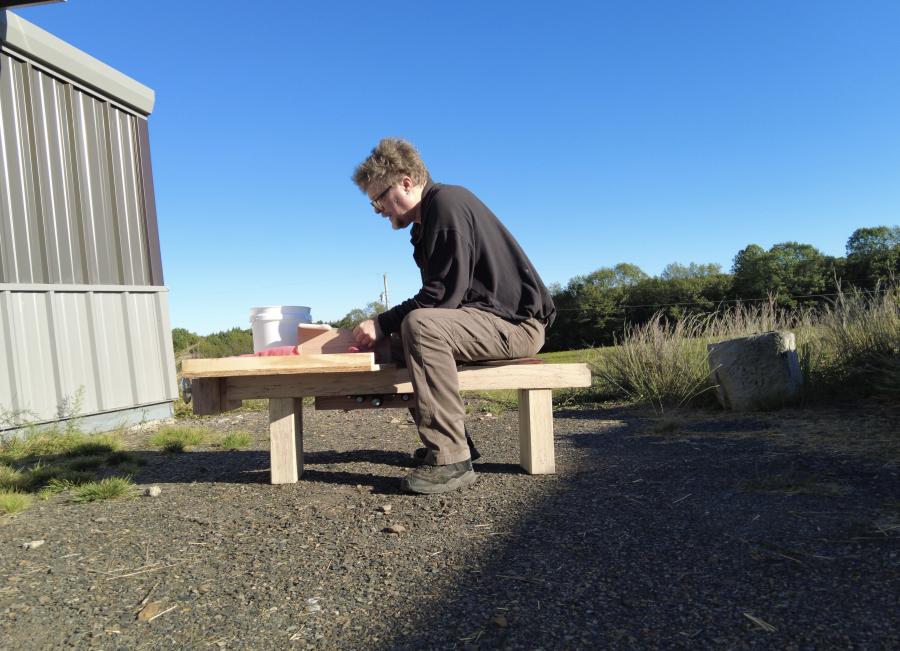Michael Bell, the master smith at Dragonfly Forge has a sort of traditional-looking Roman workbench that he uses for blade shaping.

Michael Bell at his bench
 The ergonomics are surprisingly good, since the weight of your arms gives a good push to the blade on the stone, and you’re not crouched over. If you’ve ever seen pictures of a traditional Japanese sword-polisher’s set-up, it looks incredibly awkward (though the one sword-polisher I’ve talked to says its surprisingly comfortable) – being a pretzel is not for me. I guess it’s a testament to how much our sense of physical comfort is learned and not exactly innate.
The ergonomics are surprisingly good, since the weight of your arms gives a good push to the blade on the stone, and you’re not crouched over. If you’ve ever seen pictures of a traditional Japanese sword-polisher’s set-up, it looks incredibly awkward (though the one sword-polisher I’ve talked to says its surprisingly comfortable) – being a pretzel is not for me. I guess it’s a testament to how much our sense of physical comfort is learned and not exactly innate.
I need a bench like sensei Bells’. When I went to Hickory Hollow sawmill, one of the things I brought home was a 6′ long slab of 10-year old maple, 11″ wide and 4″ thick. After a few runs through the bandsaw and table saw and planer, I had it mostly squared up, and the rest was pretty straightforward. To give it a nice “organic” look, I eyeballed everything once it came off the table-saw. That’s my story and you can’t budge me from it.
The legs are attached using 10″ long pieces of 1 1/4″ oak dowel and a bunch of epoxy. I admit I did sit there thinking for a while that I could cut a great big dovetail (simple job with a table-saw and 10 hours of chisel-work) but, no, I wanted to get the job done.* So I put some epoxy on the “legs” and drilled straight down with a forstner bit, mixed a bunch of resin, poured it in, and hammered the dowels down with my mallet of loving correction. I cross-cut the ends of the dowels and hammered maple wedges down into the slots because: why not?

One change I made over sensei’s bench is the clamp at the front. The hand-wheels are on 2 pieces of 1/2″ threaded rod 24″ long, which go into pocket-holes drilled in the slab. With that clamp arrangement, I can swap the utility surface mounted on the bench – either a clamp-down thingie for holding the tang of a blade while I hand sand it:

Or a more traditional-ish base for a whetstone, bucket, rags, whatnot. I have both kinds of music, country and western, see? It’s already come in pretty handy. If I ever need something else, I’ll make an attachment and go on with it. Also, I have been planning to drill holes for bench dogs in the clamp (and turn some pretty bench dogs on the lathe, because: lathe!)
In the image above you can also see another non-traditional addition: a wet-formed leather butt pad filled with a nice thick piece of closed cell rubber foam. It’s a bit slippery but I think it’ll roughen up over time. Or I’ll sand it.

That’s kind of a faked shot because the bench actually lives inside the building and it’s not a whole lot of fun to move. Since it’s old maple, it’s only 1,382,291 pounds. I’m almost glad I didn’t decide to spring for the walnut slab they had drying in the kiln, but I didn’t want to wait. In the shot above I’m using a more traditional stone-holder, which keeps the stone at a nice angle, and allows you to wedge the stone in tightly with a pair of mated wedges. So that is an actual picture of me working on shaping the edge of a cooking knife that I’m resurrecting, slowly.

I have to say it wounded my soul a bit to use normal threaded rod instead of cutting my own acme thread rod on the lathe, but I needed the project done in my lifetime. Rigging the rods was fun: I just drilled two 26″ holes along the deck, then drilled down from the top with a big forstner bit and hit the holes (lucky!) then I dropped a nut into each hole, threaded the rod down through it, painted it thoroughly with vaseline, poured a bunch of resin into the hole, and hammered down an oak plug. The ends of the rods are slotted (by eyeball with a diamond wheel on an angle grinder and not with the slotting saw on the milling machine because I don’t have a collet chuck to hold threaded work-pieces) – the vaseline worked, so I can run the rods in or out to where I want them before I tighten down the hand wheels.
That was a very satisfying project. I’ve already discovered that if I put on some good music, open the door, and grab a sanding block, I can get completely lost in the feeling of sandpaper on steel. It makes a high-pitched song, if you listen. Once I’ve got my hand back in, I’m going to start shaping the osoraku blade.
In the meantime, I’ve done about 2,028 other projects and I’m not sure if I’ll be able to post about them all. But, I’m busy.

Oh, the side-vice is just there because I had the hardware. And, if I ever want to file the back of a blade or something, it’ll serve well. Both of the clamps’ facings are held on with screws so if I want to replace the pretty oak with more practical poly block, I can.
* The legs are actually not as wide as the top, for reasons I can’t really explain. So if I did a dovetail there would have been an unsightly gap. Again, that is my story and I am sticking to it. OK, the FBI did it.

So what’s a “more traditional stone holder” look like? An angled box a couple wedge thicknesses longer than your stones?
Looks good, and reads as if it does what it was designed to do. Who should ask for more?
Nice bench, Marcus. Well done!
Were it my bench, I’d consider adding some triangular bracing to the legs. Even with big honking dowels set in epoxy, years of the push-pull motion of metal grinding could still loosen up those joints.
If you had decided on a morticed joint, you don’t have to chisel out all the waste. Simply make a whole lot of table saw cuts in the waste area and then pop out the thin tabs of wood with a big screwdriver. Then, just a little chiseling will smooth the floor of the mortice. You could then use your band saw or a small bow saw to undercut the angled sides of the mortice, OR since all the force on the joint is only pushing it together as opposed to pulling it apart, you could keep one or even both sides of the joint perpendicular, no undercutting needed in that case.
My only criticism is it looks a bit new, needs to develop a patina from use :P
I’ve been pondering making a shave horse type set up for hand sanding, but i don’t think i have space
Nice work! Making tools and fabricating jigs and setting up the workshop and building storage and all these meta-making activities are all extra-satisfying for some reason. Maybe because they hold the promise of all those yet-not-made things that they’re going to contribute to?
Also glad we haven’t read much from you because you’ve been busy and enjoying yourself, and not for health reasons.
My experience with those cast aluminium handwheels is that the threads don’t last.
We’re now drilling them out and hammering a steel nut in.
Cool new toy! It was fun to read about how you chose to make it.
This is what the sharpening/shaping front-piece looks like, unmounted.
rsmith@#6:
My experience with those cast aluminium handwheels is that the threads don’t last.
You’re not kidding. I got them to put on my bandsaw but they were too flimsy, so I repurposed them after they had a good long rest on the shelf.
Off-topic, the F-35 wire:
F-35 Production Paused Because an Engine Part Is Made in China
I don’t get the idea that a magnet made of metal from China is somehow a national security threat. Unless it’s in the form of a computer CPU or something like that.